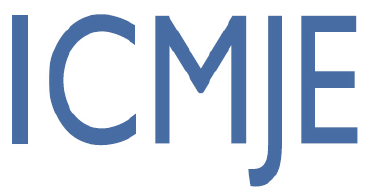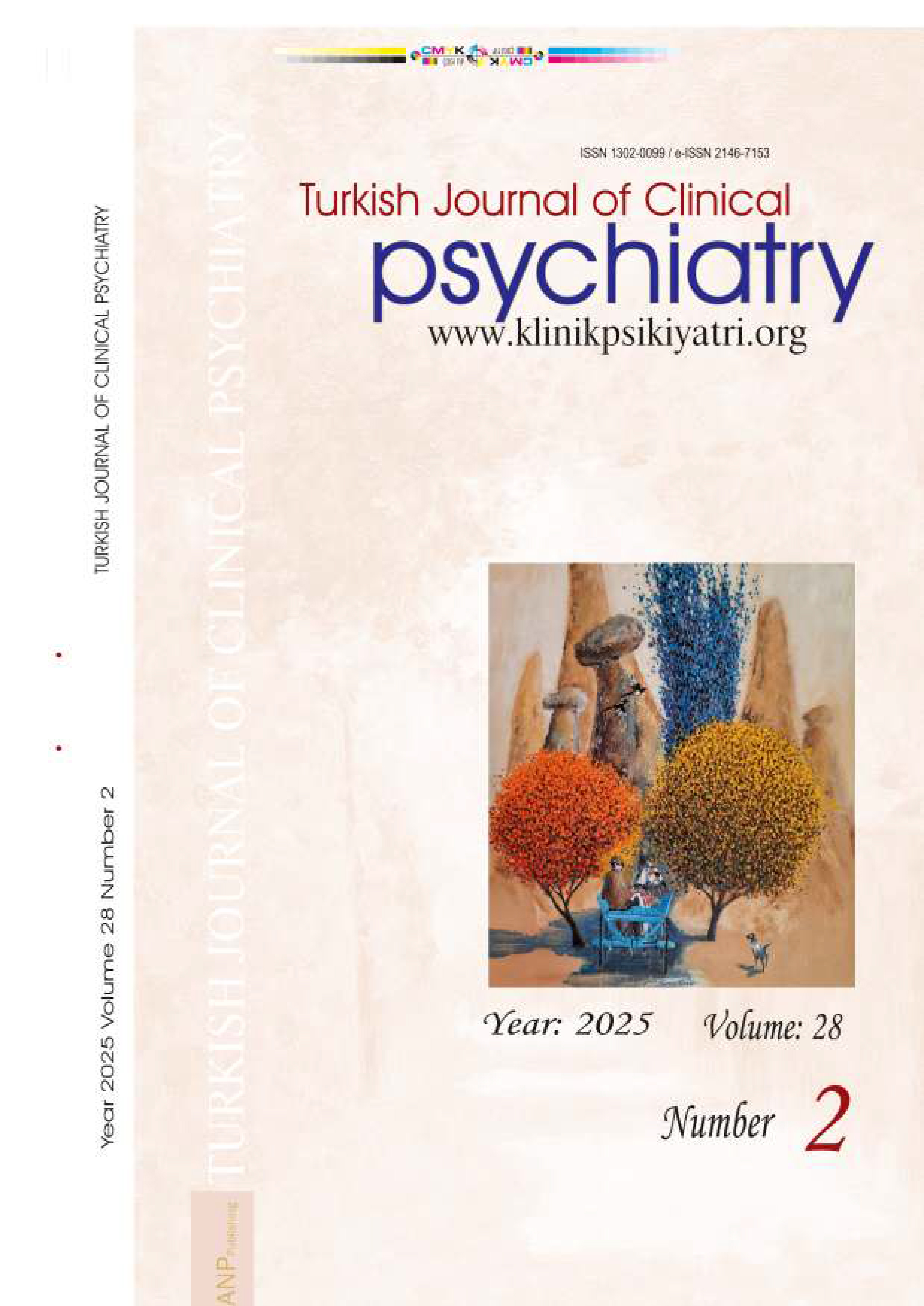





Volume: 10 Issue: 2 - 2007
| RESEARCH ARTICLE | |
| 1. | Relationship Between Age of Onset in Bipolar Disorder and Clinical, Prognostic Properties Recep Tütüncü, Sibel Örsel, M.Haluk Özbay Pages 63 - 68 Objectives: The aim of this study is to investigate the effect of age of onset on socio-demographic variables, clinical properties, prognosis and functionality in bipolar disorder. Method: The study sample consisted of 43 patients. 23 patients' age of onset was more than 20 and the rest was equal to or less than 20 years old. The patients' diagnosis was made by the help of the Structured Clinical Interview for DSM-IV-TR (SCID-I). All patients were assessed by socio-demographic form, Young Mania Rating Scale (YMRS), Hamilton Depression Rating Scale (HAM-D), and Global Assessment Scale (GAS). Results: Unemployment rate was detected significantly higher and children number lower in early onset patients. According to GAS scores there were moderate symptoms and some difficulties in functioning. No significant differences were found in terms of course of the disease. It is important to express that average duration of the illness is same in both groups (GROUP 1: 12,95 years; GROUP 2 12,09 years) and the average age of the groups are 28,80 years for GROUP 1, and 42,22 years for GROUP 2. Conclusion: Duration of the illness is more important than the age of onset in course of the bipolar disorder. Early age of onset might not be the subtype predictor alone. |
| 2. | A Study for Clarifying the Relationship Between Acne Vulgaris and Psychopathology Orhan Murat Koçak, Gökçe Silsüpür, Canan Görpelioğlu, Emel Erdal Pages 69 - 76 Objectives: Although depression and anxiety were reported often in acne, how relationship is exist between acne and psychopathology have not been clarified. This study was designed for clarifying this issue. Method: Acne patients who aged between 16-30 years old were included in this study. Every patient was given a questionnaire which comprises sociodemographic charaster- istics, Beck Depression Inventory, Beck Anxiety Inventory and Body Cathexis Scale. In additionally patients' parents were asked whether their child has an acne problem which disturbs the appearance severely or not and whose idea was it to admit the appointment for the current examination. Acne was evaluated by two dermatologist and psychiatric disorders were diagnosed according to DSM-IV by two psychiatrists. Results: Sixteen of forty five acne patients who were included the study were diagnosed with a psychiatric disorder. The patients with psychiatric disorder had higher depression and anxiety scores and lower body perception scores than patients without psychiatric disorder. However acne severity was not different between these two groups. According to duration of the acne there were no difference between the groups in the depression and anxiety scores and acne severity. Acne severity of children whose mothers said "my child has an acne problem which disturbs his/her appearance" was not significantly different than who said "my child has not an illness which disturbs his/her appearance". Conclusion: The acne works as a stressor and precipitant factor but, in the acne, determinant of significant higher scores of the depression and anxiety is the psychopathology. |
| 3. | Reliability and Validity Study of Thought and Language Index in Turkish Halis Ulaş, Koksal Alptekin, Berna Binnur Akdede, Mevhibe Tümüklü, Haluk Arkar, Yıldız Akvardar Pages 77 - 85 Objective: Thought and Language Index (TLI) is a semi- structured clinical interview scale for assessing thought and language disorders in patients with schizophrenia. This index has been translated and adapted into Turkish language in order to study its validity and reliability. Method: 82 patients with schizophrenia and 49 healthy volunteers were included in the study. Sociodemographic data form, TLI, Positive and Negative Syndrome Scale (PANSS) and Calgary Depression Scale (CDS) were administered to patients with schizophrenia. Sociodemografic data form and Structured Clinical Interview for DSM-IV /Clinical Version (SCID-I/CV) were applied to the healthy controls. For the reliability evaluation of the index interrater reliability and test-retest reliability and for the validity of the index, factor structure and differentiation capacity between patients and healthy volunteers were investigated. Results: Poverty of thought and disorganization of thought were found as two factors in TLI's factor analysis. We determined high interrater reliability (r=0.97 for poverty of thought, r= 0.72 for disorganization of thought) for TLI. Test-retest reliability of poverty of thought was higher than that of disorganization of thought (r=0.78 for poverty of thought, r=0.44 for disorganization of thought) and TLI has high differentiation capacity between patients and healthy volunteers (pcO.OOI). Distractibility item of the index was not found valid and reliable. The test retest reliability of looseness was poor. The correlation between items of CDS and TLI was not significant. Conclusion: The validity and reliability of distractibility and looseness items of TLI must be tested also in acute schizophrenic patients. |
| 4. | Normalizing Attributions Style in non-help-seeking Persons with Symptomatic Fibromyalgia Hüseyin Güleç Pages 86 - 92 Amaç: Bu çalışmanın amacı, tanı kriterlerini doldurmasına rağmen bir hastalık davranışı olan tedavi arama davranışı göstermeyen kişilerin normalizasyon atıf yapma tarzını daha fazla kullanıp kullanmadığını araştırmaktır. Yöntem: Çalışma Fiziksel Tıp ve Rehabilitasyon polikliniğine ayaktan başvuran 37 Fibromiyalji Sendromu (FMS) tanısı konan hasta ile tedavi arayışı olmayan anket çalışması ile ağrı yakınması olan ve muayenesinde FMS tanısı konan 38 hasta ve anket çalışması ile tıbbi ve psikiyatrik hastalığı olmayan, ağrısız 34 kadınla yürütüldü. Çalışmaya katılan hastalara Semptom Yorumlama Anketi (SYA), Beck Anksiyete Ölçeği (BAÖ), Beck Depresyon Ölçeği (BDÖ), Yirmi Soruluk Toronto Aleksitimi Ölçeği (TAÖ-20) ve sosyodemografik veri formu verilmiştir. Bulgular: SYA-Normalizasyon alt-testi ortalamalarının, tedavi arayışı olmayan grupta en yüksek değerlerde olduğu görülürken, normal sağlıklı grubun bunu takip ettiği ve en düşük değerlerin ise tedavi arayışı olan grupta olduğu görüldü. Gruplar arasındaki farkın istatistiksel olarak anlamlı olduğu bulundu. Normalizasyon alt-testi ile sadece TAÖ-Duyguları İfade Etmede Güçlük alt-testi arasındaki korelasyonun anlamlı olduğu bulundu. Tartışma: Tedavi arayışı göstermeyen kişiler, hem 3. basamağa başvuran hastalardan hem de sağlıklı kontrol grubundan daha fazla normalizasyon atfını kullanmaktadırlar. Normalizasyon atıf tarzı tedavi arama davranışını olumsuz etkilemekte ve bu atfı kullanmak tedavi aramama davranışına katkıda bulunabilir. |
| REVIEW | |
| 5. | Neuroimaging Techniques in Eating Disorders Esra Güney, Aslı Çepik Kuruoğlu Pages 93 - 101 Eating disorders that are commonly encountered during puberty or early adulthood period, are associated with significant mortality and morbidity. Recent advances in the neuroimaging techniques made an impact on this area. Although research has been limited compared to other psychiatric disorders, results seem promising in paving the way to better understand the etiopathoge- nesis, by way of identifying the responsible brain regions. Many studies conducted in anorexia nervosa (AN) demonstrated loss of gray and white matter, which partially recuperates during recovery, as well as an increase in the cerebrospinal fluid volume. These findings were supported by similar outcomes from magnetic resonance spectroscopic investigations. Functional imaging methods have been utilized to obtain insight to the serotonin receptor binding, regional cerebral blood flow or glucose consumption. In these studies the association of AN with affected cingulate, frontal, temporal and parietal cortices has been demonstrated. Data supporting partially ongoing malfunction after recovery, suggest the possibility that constitutional features may render the individual liable to the development of an eating disorder. A small number of studies performed on bulimia nervosa and binge eating disorder showed dysfunction in similar brain regions. In this paper, we aim to review the newly developed neuroimaging methods that have gained importance in the field of research conducted on the etiology of eating disorders. |
| CASE REPORT | |
| 6. | Temporomandibular Joint Dislocation Due To Orofacial Distonia During Antipsychotic Use: A Case Report Cebrail Kısa, Çiğdem Aydemir, Erol Göka Pages 102 - 105 Short time after discovering of classical antipsychotics in 1 950's, extrapyramidal side effects and movement disorders were observed in many patients, despite improvement of psychotic symptoms. In contrast to new antipsychotic agents, these side effects are occasionally seen in early periods of the treatment by classic antipsychotics; movement disorders occur as dystonia, parkinsonism, and akathisia however in the long term “tardive" diskine- sia, chorea, dystonia and tics may be observed. Furthermore, these extrapyramidal side effects and movement disorders cause secondary problems such as dislocations in joints, low compliance to treatment and decreased quality of life of patients. In this case report, after intramuscular injection of zuclopenthiksol, a classical antipsychotic drug, acute dystonia was occurred which is evidenced by pain in temporomandibular joint, inability to close mouth, to swallow saliva, to speak and disproportion in face. To treat this case firstly, we used biperiden and diazepam for treatment of orofacial dystonia. After dystonia did not respond to the treatment, physical examination and clinical symptoms were reevaluated. Temporomandibular joint dislocation was diagnosed following the consultations from the related departments and radiological investigations. We sedated the patient by 15 mg of Diazepam than treat the dislocation by manual reduction. As in this case report, temporomandibular joint dislocation should be considered especially in patients with orofacial dystonia after use of classic antipsychotic agents who do not respond to medical treatment. |










